The gritty politics of sand unfold through its extraction, trade, and governance, driving environmental degradation, illicit economies, and social displacement. As demand accelerates with territorial expansion and speculative urbanization around urban centers, sand’s status as a contested resource becomes increasingly pronounced, deepening the rift between sites of extraction and accumulation.
Poder Granular: A Política irregular da Areia??
Sand Matters
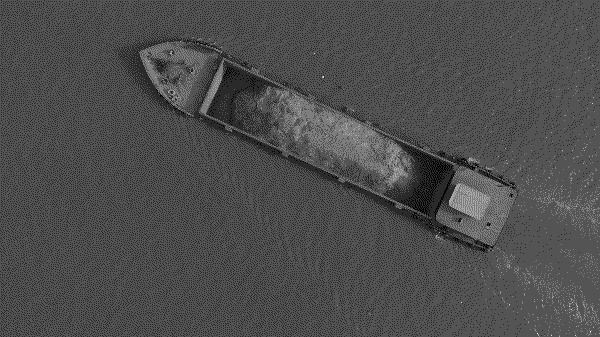
Huge amounts of sand have been and continue to be sent to Singapore, even though Vietnam officially banned sand exports in 2017. Sa Đéc, Vietnam, December 2020.
After water, sand is the second most used material in the world. Each year, approximately 40-50 billion metric tons of sand are consumed worldwide.1 This accounts for 79% of all aggregates extracted and traded, making sand the literal foundation for global human infrastructure. Sand plays a vital role in the production of glass, steel, and concrete. Silica, one of the most common minerals found in sand, is the key ingredient in silicon chips and thus for the development of digital technologies. But sand is also fundamental to the creation and maintenance of land itself, rendering it constitutive to processes of urbanization. Artificial islands, port expansions, and beach nourishment projects consume vast quantities of sand. As the bedrock of urban infrastructures, sand is embedded in the very fabric of modern life. Yet, its ubiquity belies its complexity. As a sediment, sand is foundational for the functioning of ecosystems. The relentless expansion and intensification of cities is starving rivers and coasts of sediment, depleting sand at a rate that far exceeds its natural replenishment.
Intensive dredging of rivers and seabeds has fundamentally altered sedimentation patterns, disrupting the delicate equilibrium that governs ecosystems. Rivers, which once carried sand from mountains to coastlines, now struggle to replenish beaches and wetlands. This depletion has far-reaching consequences. Without sufficient sand deposits, coastlines are left vulnerable to erosion, rising sea levels, and the devastating impact of extreme weather events. In ecosystems already on the front lines of climate change—like deltas, wetlands, and estuaries—the effects of sand extraction are compounded. Delta regions, for instance, rely on continuous sediment deposits to counteract the natural sinking of land. When sand is removed faster than it can be replaced, these regions are exposed to subsidence, where land sinks at an accelerated rate, amplifying flood risk and increasing the salinization of freshwater resources. Such impacts are often delayed, manifesting years or even decades after extraction, making them challenging to monitor and mitigate effectively.
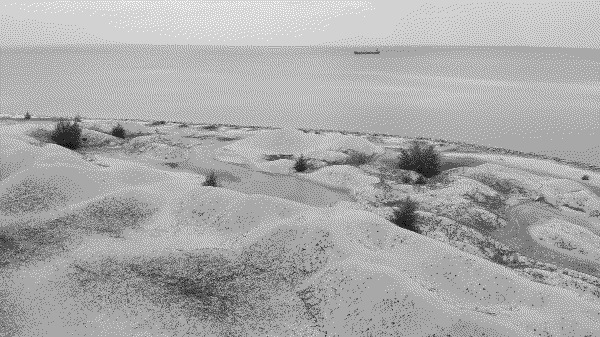
The remnants of a paused reclamation project have created an accidental new landscape. Malacca, Malaysia, January 2020

As inúmeras marcas no chão indicam o fluxo constante de caminhões entregando areia para alimentar a nova terra.
Penang, Malásia, janeiro de 2020.
As global sand consumption surges to unprecedented heights, the profound and far-reaching consequences of extraction come sharply into focus.2 Numerous journalistic and scientific accounts warn of the “looming tragedy of the sand commons,” highlighting environmental concerns related to dredging and mining sand, such as pollution, biodiversity loss, and soil disturbance, as well as illegal practices in the sand trade.3 The reality of the sand trade is both dirty and messy, intertwining national and transnational politics. In regions like Southeast Asia, rapid urbanization and investments in large-scale infrastructure projects have spurred an unprecedented demand for this essential resource. Here, land reclamation has emerged as a flashpoint where extraction practices intersect with issues of sovereignty, livelihoods, and environmental justice, transforming sand into a highly sought-after and contested commodity. Building new land for some means taking old land from others. The exploitation of sand goes hand in hand with exploitative labor and geopolitical maneuvering.
Sand’s impending scarcity has fueled a black market, giving rise to “sand mafias”—criminal organizations that exploit extraction and trade through corruption, violence, and intimidation, often circumventing national mining and export bans.4 It is not uncommon for sand to become a matter of life and death for those who mine it as well as for those who seek to prevent it from being mined. Across the world, activists and local communities have mobilized against sand extraction and land reclamation, fighting the prevailing narratives of development and progress that often justify environmental exploitation. However, these initiatives are rarely successful, resulting (at best) in compensation payments to the affected communities. A transboundary governance of sand would require international standards, which many researchers and organizations have requested.5 Even so, it is nearly impossible to control the natural flow of sand.
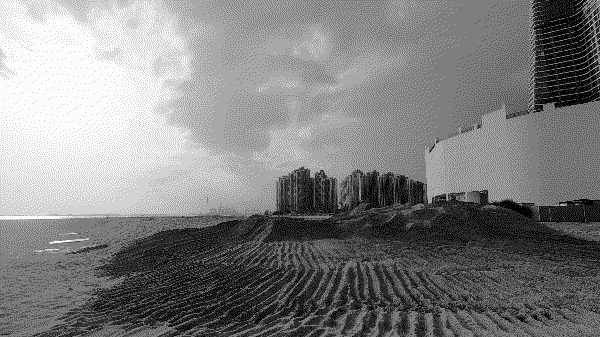
Remnant sand piles at Forest City, a recently reclaimed island and eco-smart city in Johor, Malaysia. January 2020.
As sand transitions from a sediment to a precious resource, it has become instrumental in urban ideals of late modernity. Cities like Dubai and Singapore epitomize how architectural ambitions is built on vast quantities of imported sand. Land built from scratch, towering skyscrapers, and sprawling infrastructure are testaments to sand’s transformative potential. Yet, these urban landscapes are haunted by their materiality: each grain is a silent witness to the ecological and social disruptions that enabled its journey. The sand in these structures embodies the persistence of environmental degradation, displaced labor, and the exploitation that made them possible.6 In this way, sand is both an architect and a specter of modernity’s unrestrained ambitions, leaving us to confront the shadows cast by our own constructions.
Resourcification
Sand’s journey begins deep within Earth’s crust, where geological processes lasting millennia gradually give rise to its form. It takes hundreds of years for a mountaintop to erode and for the particles to travel, via wind and rivers, eventually arriving as sand on beaches or riverbeds. If left unextracted, sand would continue to decompose, sinking deeper into the earth. Geographer Michael Welland describes a volcanic eruption as the birth of a grain of sand, a poetic metaphor that overlooks the reality that most sand is extracted from the geological cycle through practices like river and seabed dredging.7 The circulation of sand is not a one-way process; rather, it is continually eroded, transported, and deposited. Coastal zones, river deltas, and underwater environments all serve as temporary storage areas for sand before it’s moved again by natural forces. This cycle maintains a balance within ecosystems, distributing sediment across various landscapes. However, human activities like sand mining, river damming, and coastal development can disrupt this balance, reducing sediment flow and causing increased erosion and habitat loss.

Left: Sand ruler in the laboratories of Deltares, the Dutch Delta Research Institute in Delft, November 2020. Sand is defined by its grain size. Right: Sand is sorted by a conveyor belt before being transferred to trucks for distribution to local construction sites. Clark, Philippines, November 2018.
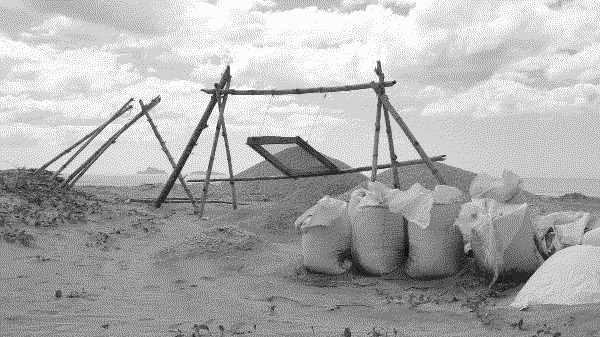
Sand is sorted by a conveyor belt before being transferred to trucks for distribution to local construction sites. Clark, Philippines, November 2018
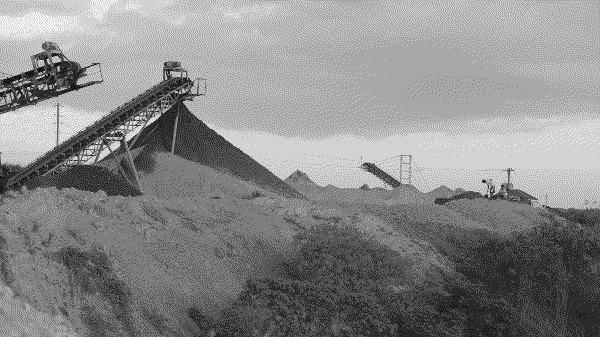
A makeshift sand sorting facility. Here, sand is illegally dug from the beach, bagged, and labeled as sugar before being collected by boots. San Narciso, Philippines, November 2018
Not all sand is suitable for construction; only marine and river sand, with their angular grains formed by water movement, provide the necessary adhesion and stability for building mass and landfill. In contrast, desert sand is primarily shaped by wind, which leads to rounded grains with a hardened core, making it unsuitable for construction. This created a paradox in Dubai, where, despite its sand-rich geography, it had to import sand from Australia for the creation of its palm-tree-shaped islands. However, researchers and engineers are exploring technologies to transform desert sand into a viable construction material to address sand’s increasing scarcity. For instance, in 2018, a start-up named Finite gained attention for developing a biodegradable construction material based on desert sand. 8 Meanwhile, the Singaporean government is experimenting with a construction material made from processed waste, called NEWSand.9 Nonetheless, the large-scale application of these alternative materials remains uncertain.
The granular nature of sand facilitates its smooth handling, whether it is packed in bags, loaded onto trucks, transported through pipelines, or shipped across oceans. And, as a so-called “common pool resource,” sand is considered “free,” and therefore cheap to extract. 10 The only costs associated with sand are in its procurement and transportation, which is why sand is typically extracted close to where it is needed. Sand is mined from open pits, scooped up from beaches, or dredged from riverbeds, lakes, and ocean floors. Defined only by its grain size, it is typically composed of rocks, minerals, shells, and plant debris. Quartz is the most common component, making up about 70% of naturally occurring sands. 11 Theoretically, however, any particle between 0.0625 and 2 millimeters in size is classified as sand; smaller particles are referred to as silt, while larger particles are considered gravel.12
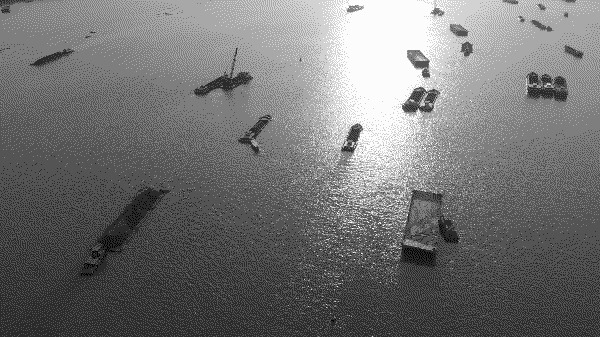
O rio Mekong foi intensamente dragado por décadas, levando à erosão e ao rebaixamento do solo.
Rio Mekong, próximo a Sa Đéc, Vietnã, dezembro de 2019.
Size is the defining parameter of sand due to its physical properties. As a granular material, its behavior depends on the interaction between individual grains and their environment.13 In its dry state, and depending on its energy distribution, sand can act either as a fluid or a solid; it can clog or liquefy, with the latter often occurring during earthquakes. Vibrations cause sand to reorganize, turning seemingly solid ground into sinkholes. When wet, sand behaves like a solid; when too wet, it acts like a fluid. Sand also behaves like a gas when strong winds can cause it to disperse into the air, jumping around seemingly chaotically. Thus, sand exhibits disordered behavior at the granular level, but en masse, it enacts phenomena such as avalanches, segregation, and liquefaction.14 The physics of granular matter are considered surprising and counterintuitive, with no comprehensive model capable of fully explaining its complex multiphase behavior.
Despite being one of the most widely used construction materials in the world, sand’s granular physics poses problems for its precise calculability, and thus the ability to control it effectively. Sand’s granularity both enables its widespread manipulation and complicates its management. This contradiction provides a powerful lens through which to examine the gritty politics of sand as a site where geological forces and human intervention are in constant negotiation. Sand’s granular nature allows it to be easily extracted, transported, molded, mixed, and transformed into versatile building blocks, whether for the foundations of cities or cutting-edge technology. This same granularity, however, makes sand an inherently unstable asset, constantly shifting both physically and in terms of governance. As such, sand acts as both agent and substrate of environmental transformation, blurring the line between material and infrastructure.

Ballast-Heavers at work in the pool. Source: Henry Mayhew, London Labour and the London Poor, Vol. 3 (London, 1851), 277.
Sand (and) Politics
In the eighteenth century, advancements in ship transportation, dam construction, and the straightening of rivers for improved navigation prompted a closer study of sand behavior. Engineers and natural scientists became increasingly interested in understanding how sand moved and settled, as these granular dynamics directly impacted the stability of waterways, the longevity of dams, and the safety of shipping routes. Observing the effects of erosion, sedimentation, and shifting sandbanks, they sought methods for controlling sand’s unpredictable movements, making it possible to better manage river currents, prevent blockages, and maintain navigable channels. This period marked a critical step toward modern hydraulic engineering and sedimentology, as sand’s behavior became essential to accommodating the growing needs of industrial transport and infrastructure.
As Laleh Khalili observes, sand has only recently gained recognition as a commodity in its own right.15 Historically, the trade in sand was an incidental outcome of marine commerce, as ships often used sand or gravel as ballast. This ballast would be loaded at one port and unloaded at another, leaving deposits of aggregate on quaysides across the globe. Initially extracted to support maritime trade, these aggregates found new uses in the nineteenth century for building construction and road-making. The advent of containerized shipping in the mid-twentieth century then triggered a significant expansion in the dredging industry; as ships became heavier, they demanded deeper waterways, yielding large quantities of dredged sand suitable for repurposing.16 Even today, the ongoing maintenance of navigational channels generates a steady supply of granular material, often redirected toward large-scale land reclamation projects.
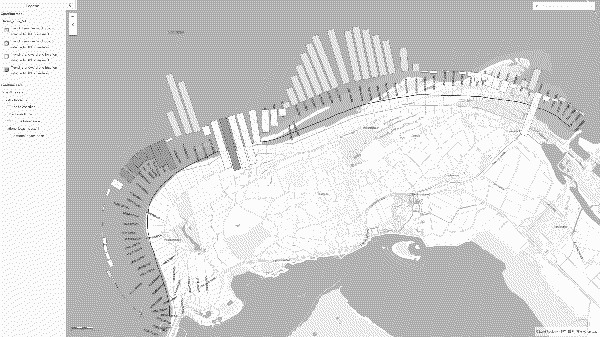
Map of coastal erosion compared against the so-called "reference coastline" (basiskustlijn) around the port of Rotterdam. Source: Ministry of Infrastructure and Water Management of the Netherlands.
The rise of a specialized dredging and land reclamation industry has been led by the Dutch, whose extensive history of coastal engineering has driven innovations in sand extraction, transport, and landscape modulation. Faced with a steadily receding coastline, the Netherlands made a landmark decision in 1990 to establish a fixed shoreline position.17 Preserving this artificial boundary requires the extraction of twelve million tons of sand from the North Sea each year, sand that is then strategically deposited along the coast to counter erosion. While Dutch engineers are exploring new, sustainable methods for shoreline replenishment, the effort to maintain the country’s coastline remains a highly labor-intensive and costly endeavor. Dutch expertise in dredging and land reclamation is not only essential for maintaining the country’s own coastline but has also positioned the country as a global leader in coastal engineering.
While European reclamation efforts have often focused on stabilizing coastlines and protecting against sea-level rise, countries like China and Singapore have pursued land reclamation on a much larger scale, reshaping coastlines and creating extensive new land areas for urban development, industrial zones, and military purposes. For instance, to bolster its territorial claims in the South China Sea, China has been strategically constructing artificial islands between its mainland and the Spratly Islands, whose sovereignty has been contested by China, Vietnam, the Philippines, and Malaysia. China’s artificial islands serve not only as a geopolitical tool, but also as a means of securing strategic advantages in an area that is critical for international trade. Meanwhile, Singapore has expanded its landmass by about 25% over the past fifty years as it transformed into an independent state and Southeast Asia’s largest economy.18 However, border conflicts with neighboring Malaysia and Indonesia, as well as Singapore’s questionable sand procurement practices, have made sand trading and land reclamation highly contentious issues in the region.19 Sand availability has become a critical security issue for the nation-state, with dwindling supplies prompting Singapore to stockpile sand for future reclamation and infrastructure projects.
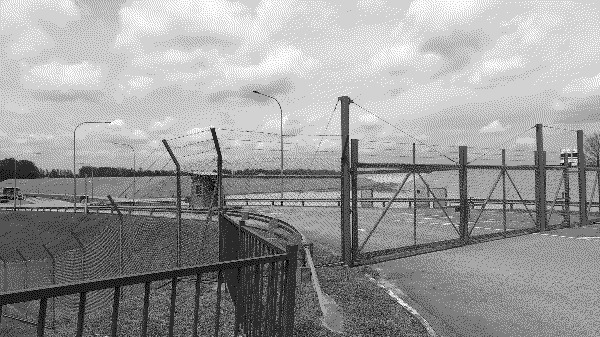
To prevent sand shortages, Singapore maintains large sand reservoirs. Singapore, January 2020.
Khalili describes land reclamation as a form of modern “piracy,” highlighting how sand is often extracted from so-called “borrow areas” with varying degrees of legality.20 These areas can be located in riverbeds, coastal zones, or offshore seabeds—places where sand is naturally deposited by geological and hydrological processes—and are generally overseen by regulatory bodies. In practice, however, sand is frequently extracted with minimal oversight or in violation of regulations. While “reclamation” suggests the rightful retrieval of land from the sea (which for most land reclamation projects is factually incorrect), “to borrow” further obscures the extractive practices inherent in land reclamation as a political technology whose central aim is the commodification of nature for economic and political gain. For instance, Singapore has primarily sourced its sand from neighboring countries through procurement schemes that are often obscured through various forms of subcontracting, which absolves the country of any responsibility for the consequences.21 As Singapore’s territory and economy expand, the countries providing sand face significant environmental and social repercussions and heightened economic dependency.
When sand is unearthed and shifted, its legal and economic status shifts too. Extracted as a cheap resource in one place, it is converted back into land and becomes naturalized as ground and territory in another. Milica Topalović has described this conversion as “alchemy.” 22 Sand’s origin is not what matters, but rather its uptake: sovereignty over the territory where it settles.23 That sand is constitutive for certain life forms—that it is essential for place-making and thus beyond measure—is not part of this calculation. This “extractive view” implies not only that sand is turned into a resource, but also that other ways of being-with-sand are devalued.24 Resources in general, and sand in particular, implicate a continuum suspended between “a past ‘source’ and a future ‘product.’”25 Turning sand into land and infrastructure implies more than the physical transformation of matter. It is first and foremost the generation of economic value against which other forms of meaning-making are discounted.
Granular Power
Sand, land, territory, and governance visibly converge in the practice of land reclamation. What may initially appear as a formula for success quickly transforms into a source of risk when sand supply dwindles. Often regarded as an inexhaustible resource, sand is typically overlooked in regulatory frameworks because it is not considered valuable enough to warrant oversight. However, as with many natural resources, sand is taken for granted until the effects of its scarcity have become undeniable. The erosion or flooding of a riverbed or seafront, or the encroachment of one nation’s territorial claims on another’s, reveals sand’s political nature. As grains of sand accumulate, disperse, and coalesce, their impact reverberates across multiple interconnected systems—economic, environmental, and social.
From its geological origins to its critical role in urban infrastructure, the journey of sand exposes a fundamental truth: sand, and, by extension, land, is intrinsically unstable. This inherent instability arises not only when sand is extracted and transformed, but also through its inevitable erosion, defying efforts at control. Composed of rocks, shells, and organic materials, sand is prone to natural decomposition, making stabilization an arduous and often futile task. Reclaimed land in particular is highly susceptible to erosion and requires constant replenishment to prevent collapse, which only further fuels ongoing demand. Yet, each extraction and transformation of sand, whether for construction projects, beach nourishment, or infrastructure development, further unsettles this fragile balance.
The gritty politics of sand reflect broader questions about the forms of control, dependency, and influence that sand’s availability, scarcity, and regulation (or lack thereof) enable. The effects of shifting sands are real, visceral, and affect individuals and communities in tangible ways. Sand’s complex nature mirrors the challenges of governing it as a resource, where its granular essence becomes a focal point for intersecting political, economic, and environmental forces. In a world where both natural and geopolitical boundaries blur, the very substance of land has turned into a slippery frontier. In all its granular complexity, sand is a testament to the ephemeral nature of human ambitions—a constant reminder that even the most solid-seeming foundations can, and will, erode.
Footnotes
- United Nations Environment Programme, “Sand and Sustainability: Finding New Solutions for Environmental Governance of Global Sand Resources: Synthesis for Policy Makers” (Geneva: United Nations Environment Programme, 2019).
- Orrin H. Pilkey et al., Vanishing Sands: Losing Beaches to Mining (Durham, NC: Duke University Press, 2022).
- Environmental Reporting Collective, “Beneath the Sands,” https://www.beneaththesands.earth/, 2023; Vince Beiser, The World in a Grain: The Story of Sand and How It Transformed Civilization (Riverhead Books, 2018); United Nations Environment Programme, “Sand and Sustainability”; United Nations Environment Programme, “Sand and Sustainability: 10 Strategic Recommendations to Avert a Crisis” (Geneva; United Nations Environment Programme, 2022); Aurora Torres et al., “A Looming Tragedy of the Sand Commons,” Science 357, no. 6355 (2017); Mette Bendixen et al., “Time Is Running out for Sand,” Nature 571, no. 7763 (July 2019): 29–31; Vanessa Lamb, Melissa Marschke, and Jonathan Rigg, “Trading Sand, Undermining Lives: Omitted Livelihoods in the Global Trade in Sand,” Annals of the American Association of Geographers 109, no. 5 (2019): 1511-1528; Christina Larson, “Asia’s Hunger for Sand Takes Toll on Ecology,” Science 359, no. 6379 (March 2, 2018): 964–65; Nicholas Magliocca et al., “Comparative Analysis of Illicit Supply Network Structure and Operations: Cocaine, Wildlife, and Sand,” Journal of Illicit Economies and Development 3, no. 1 (October 4, 2021): 50–73; Global Witness, “Shifting Sands: How Singapore’s Demand for Cambodian Sand Threatens Ecosystems and Undermines Good Governance” (London: Global Witness, 2010).
- Arpita Bisht, “Conceptualizing Sand Extractivism: Deconstructing an Emerging Resource Frontier,” The Extractive Industries and Society 8, no. 2 (June 2021): 100904; Lamb, Marschke, and Rigg, “Trading Sand, Undermining Lives”; Global Witness, “Shifting Sands.”
- Bisht, “Sand Futures”; Michelle Ann Miller, “A Transboundary Political Ecology of Volcanic Sand Mining,” Annals of the American Association of Geographers 112, no. 1 (January 2, 2022): 78–96; United Nations Environment Programme, “Sand and Sustainability: 10 Strategic Recommendations to Avert a Crisis.”
- Jacques Derrida, Spectres de Marx (Paris: Galilée, 1993).
- Michael Welland, Sand: The Never-Ending Story, 1st Edition (University of California Press, 2009).
- India Block, “Desert Sand Could Offer Low-Carbon Concrete Alternative,” Dezeen, March 24, 2018, https://www.dezeen.com/2018/03/24/desert-sand-could-offer-low-carbon-concrete-alternative/.
- Timothy Goh, “Processed Waste Known as NEWSand May Be Used as Construction Materials Here,” Straits Times, November 25, 2019, https://www.straitstimes.com/singapore/processed-waste-known-as-newsand-may-be-used-as-construction-materials-here.
- Lamb, Marschke, and Rigg, “Trading Sand, Undermining Lives”; Torres et al., “A Looming Tragedy of the Sand Commons.”
- Welland, Sand, 4.
- Chester K. Wentworth, “A Scale of Grade and Class Terms for Clastic Sediments,” The Journal of Geology 30, no. 5 (1922): 377–92.
- Bruno Andreotti, Yoel Forterre, and Olivier Pouliquen, Granular Media: Between Fluid and Solid (Cambridge: Cambridge University Press, 2013), 5.
- Andreotti, Forterre, and Pouliquen, Granular Media, 1.
- Laleh Khalili, “A World Built on Sand and Oil,” Lapham’s Quarterly, May 13, 2019, https://www.laphamsquarterly.org/trade/world-built-sand-and-oil.
- Ashley Carse and Joshua A. Lewis, “New Horizons for Dredging Research: The Ecology and Politics of Harbor Deepening in the Southeastern United States,” WIREs Water 7, no. 6 (November 2020): e1485.
- Hillen Roeland and Roelse Piet, “Dynamic Preservation of the Coastline in the Netherlands,” Journal of Coastal Conservation 1, no. 1 (1995): 17–28.
- Michaela Büsse, “Reclaiming Nature and Identity: Extractive Legacies in Singapore Development History,” in Robert Zhao Renhui: Seeing Forest, vol. 2, eds. Anna-Sophie Springer and Etienne Turpin (Berlin/Singapore: K. Verlag and Singapore Art Museum, forthcoming 2025).
- Joshua Cameroff, “Built on Sand: Singapore and the New State of Risk,” Harvard Design Magazine 39, Winter 2014.
- Khalili, “A World Built on Sand and Oil.”
- Global Witness, “Shifting Sands.”
- Milica Topalović, “Constructed Land: Singapore in the Century of Flattening,” in Constructed Land: Singapore 1924-2012 (Zurich: ETH Zurich DArch and Future Cities Laboratory, 2014), 56.
- Tania Murray Li, “What Is Land? Assembling a Resource for Global Investment,” Transactions of the Institute of British Geographers 39, no. 4 (October 2014): 589–602.
- Macarena Gómez-Barris, The Extractive Zone: Social Ecologies and Decolonial Perspectives (Durham, NC: Duke University Press, 2017).
- Mandana E. Limbert and Elizabeth Emma Ferry, Timely Assets: The Politics of Resources and Their Temporalities (Santa Fe: SAR Press, 2009), 6.